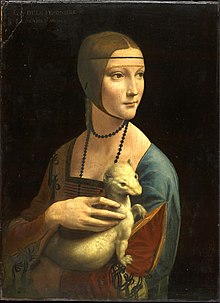User:Mats84/His Dark Materials
Setting[edit]

The series is set in a world where a human individual's soul[2] manifests itself throughout life as an animal-shaped "dæmon", who almost always stays near its human counterpart. During the childhood of its associated human, a dæmon can change its animal shape at will, but with the onset of adolescence it settles into a fixed, final animal form. Dæmons can converse with people and fully interact with the physical world, although physical contact between a human and another person's dæmon is considered taboo.
The series' world has many parallels with our own, as well as differences and divergences in history. Russia is called Muscovy; countries called New France and New Denmark exist in North America; Lapland is a kingdom; Britain is spelled "Brytain". Dress style resembles that of the UK's Edwardian era[citation needed]. Zeppelins are widely used for military and civilian air travel; there are also helicopters ("gyropters") and hot air balloons. Electricity is called "anbaricity". Elementary particles, such as electrons, are known to science. There are also various fantastical elements: witches flying on pine branches, intelligent armoured polar bears, cliff-ghasts, etc.
The world is one where the Church exerts a strong control over society, suppressing views and scientific discoveries which it deems heresy. The Church is similar in organisation to the Roman Catholic Church, but one in which the centre of power has been moved from Rome to Geneva by Pullman's fictional "Pope John Calvin" (Geneva was the home of the historical John Calvin).[3][4] The papacy was abolished after Calvin, and the Church is governed by a body called the Magisterium. The religion of the Church is explicitly called Christianity at one point[5]. Central to the plot are the biblical story of Adam and Eve, and the concept of original sin. God is also referred to as "the Authority".
Besides the aforementioned world, a multiverse of many parallel worlds exists, several of which are visited in the second and third books. One of them, home to the character Will Parry, is a fictional version of our own contemporary world. Both Lyra and Will live in their world's version of Oxford. Other locations explored in Lyra's world include London, Lapland[6], Svalbard, Siberia, and the Himalayas.
- ^ Robert Butler (3 December 2007). "An Interview with Philip Pullman". The Economist. Intelligent Life. Archived from the original on 5 March 2008. Retrieved 10 July 2008.
- ^ "Pullman's Jungian concept of the soul": Lenz (2005: 163)
- ^ Northern Lights chapter 2: "Ever since Pope John Calvin had moved the seat of the papacy to Geneva … the Church's power over every aspect of life had been absolute"
- ^ Squires (2003: 61): "Religion in Lyra's world...has similarities to the Christianity of 'our own universe', but also crucial differences…[it] is based not in the Catholic centre of Rome, but in Geneva, Switzerland, where the centre of religious power, narrates Pullman, moved in the Middle Ages under the aegis of John Calvin".
- ^ Northern Lights chapter 19: "She promised you that she'd get the Magisterium in Geneva to agree that you could be baptised as a Christian..."
- ^ Northern Lights chapter 10: "John Faa and the other leaders had decided that they would make for Trollesund, the main port of Lapland."
